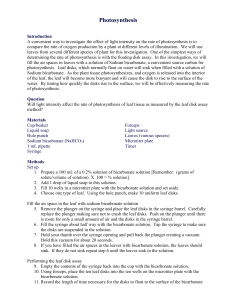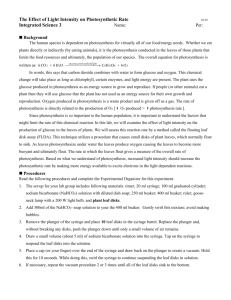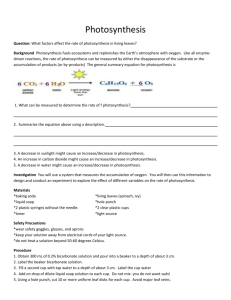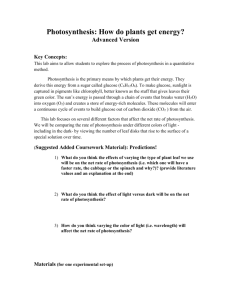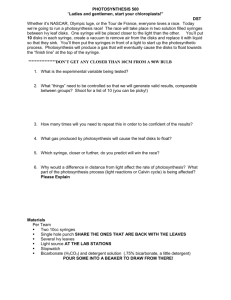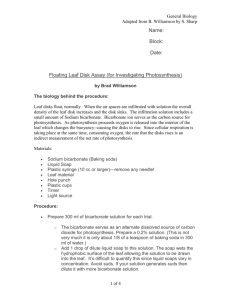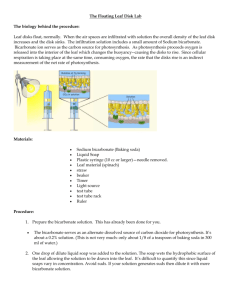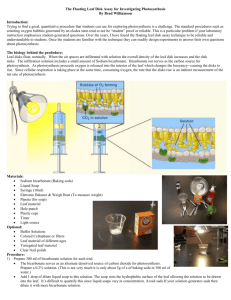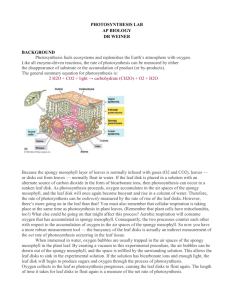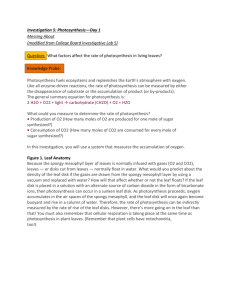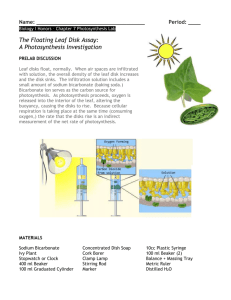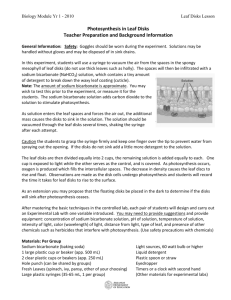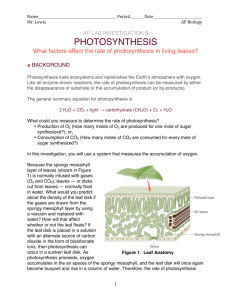IB Biology Higher Level Lab Report
advertisement
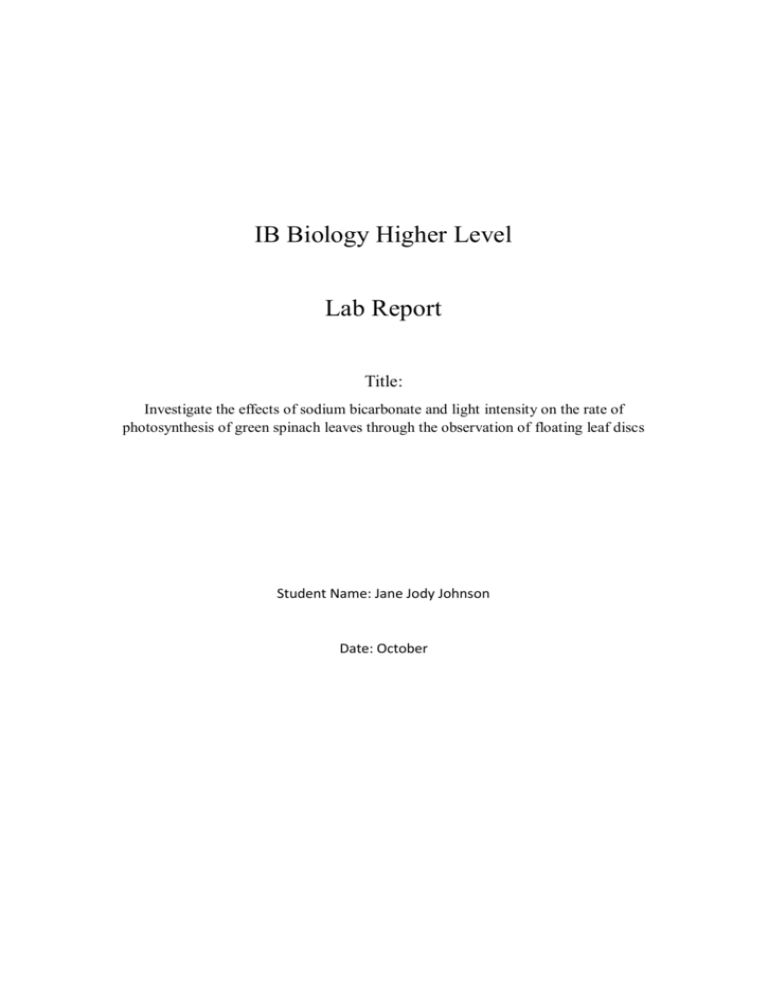
IB Biology Higher Level Lab Report Title: Investigate the effects of sodium bicarbonate and light intensity on the rate of photosynthesis of green spinach leaves through the observation of floating leaf discs Student Name: Jane Jody Johnson Date: October Title: Investigate the effects of sodium bicarbonate and light intensity on the rate of photosynthesis of green spinach leaves through the observation of floating leaf disks Background information: When light is absorbed by leaf pigments such as chlorophyll a or b, electrons within each photosystem are boosted to a higher energy level. The leaves then produce ATP, to reduce NADP to NADPH, and incorporate CO2 into organic molecules in a process called carbon fixation. When leaves are put in the water and undergo the process of the light-dependent reaction, oxygen is produced and released into the interior of the leaf which causes them to rise. However, cellular respiration is also occurring at the same time, consuming the oxygen produced in photosynthesis. The leaves must have a carbon source provided to them to allow photosynthesis to carry on. The amount of light the plant receives coupled with the amount of available CO2 will influence the rate at which photosynthesis occurs. The aim of this experiment is to measure the effect of light intensity and availability of carbon and their effects of the rate of photosynthesis. Hypothesis If the leaf is exposed to higher intensity of light in the presence of a carbon source, then it takes less time for the leaf disks to float to the surface of the solution due to an increased rate of O2 production through photosynthesis. Control variables Temperature Volume of infiltration solution Species of spinach Variables Independent Variables Intensity of light Presence of CO2 Size of leaf discs 1 Dependent Variables Time it takes for disks to float Controlling variables: 1. Control variables: a) Temperature- the experiment is set up in the same laboratory, so the temperature is kept approximately constant the whole time. b) Volume of infiltration solution- the solution is sucked out by the syringe, and it reads to 3 cc. c) The species of spinach is Spinacia oleracea. d) Leaf discs we cut into uniform circles using a standard hole punch. e) Existence of bicarbonate in the solution- 6.3g of bicarbonate is measured with a 6.3±0.02g balance 2. Independent variable: a) Intensity of light- the same light is used in every trial, with the distance from the sample measured from a metric ruler to 20±0.05cm and 10±0.05cm b) 3. Dependent variable: a) The time it takes for the disks to float to the top is kept by a standard stopwatch, and recorded every minute with an uncertainty of ±0.1s. Materials 6.3 g Sodium Bicarbonate (baking soda) Dawn brand original scent liquid soap 1 Plastic Syringe (10 cc or larger) Spinach leaves(Spinacia oleracea) 4 clear plastic cups 1 Stopwatch (iPod) 1 Regular 15W microscope light 1 Hole punch 2 beakers (30mL) 1mL or 5mL plastic disposable pipette Metric ruler Stirring rod Iron stand VI. Procedures 1. Label 4 cups with the following: - 20 cm CO2 light - 10 cm CO2 light - 10 cm Water/ soap light - CO2 dark 2. Label the 2 beakers: 1 and 2 3. Weigh 6.3g of baking soda and mix it in 300mL of water in beaker number 1, stir with the stirring rod. 4. Mix a squirt of soap with 200mL of water in beaker number 2, also stir with the stirring rod. 2 5. Using the plastic pipette, add one drop of the diluted soap solution in beaker 1 into beaker number 2. Avoid suds, and if your solution generates suds, dilute it with more bicarbonate. 6. Hole punch 10 uniform leaf disks for each of the 4 trials, pay attention to avoid major veins in the leaf. 7. Remove the plunger of the syringe and place your leaf disk in the syringe barrel. 8. Replace the plunger into the syringe and slowly push on the plunger to remove as much air as you can from the barrel without crushing the leaf disks. 9. Dip the opening of the syringe into the bicarbonate solution in beaker number 1, and pull back the plunger in order to obtain 3cc of the bicarbonate solution in the syringe. Tap the syringe to suspend the leaf disks in the solution. 10. Carefully push the plunger to leave as little air as possible inside the syringe. Hold a finger over the syringe opening, draw back on the plunger to create a vacuum. Hold this for 10 seconds. 11. While holding the vacuum, swirl the leaf disks to suspend them in the solution, then let off the vacuum. 12. If you need to, repeat the vacuum steps 2-3 times more, until all the disks in the syringe sink in the solution. 13. If the disks still do not sink, add more soap to the solution and repeat steps 7-12 14. Pour the disks and the solution into the correct cup 15. Add the bicarbonate solution from beaker number 1 until the cup is 3/4 full 16. Place cup with leaf disks under a 15W microscope light above on an iron stand 17. For trial 1 “20 cm CO2 light”, as mentioned in step one, place the light 20cm directly above the bottom of the iron stand; for trial 2 and 3, place the light 10cm above the bottom of the iron stand 18. As soon as the leaf disks in the cup are exposed to the light, begin timing 19. Record the number of disks that are floating at the end of every minute 20. Gently swirl the disks with a stirring rod to prevent them from sticking on the side of the cup and repeat the step until all the disks are floating or until you have reached 30 minutes 21. Repeat the water/soap under the light (10cm) except replace the bicarbonate solution with the diluted soap in the plunger 22. For the dark, follow all steps and keep the cup under the light of 10cm above for 14 minutes, counting the disks every minute. At 14 minutes, shut off the light and place the cup in the dark 23. Every minute, count how many disks are still floating until all the disks have sunk or you have reached 30 minutes 24. Gently swirl the disks with the pipette to be certain all disks have been properly displaced 3 Results Raw data collection The number of disks floating over time under different light intensity and different solutions Time (min) 1 2 3 4 5 6 7 8 9 10 11 12 13 14 15 16 17 18 19 20 21 22 23 24 25 26 27 28 29 30 Trial 1 20 cm CO₂ Light 0 0 0 0 0 0 0 0 0 0 0 0 0 0 0 1 2 2 2 2 2 2 2 2 2 2 2 2 2 1 Number of floating disk Trial 2 Trial 3 10 cm CO₂ Light Water/soap 10 cm 1 0 1 0 1 0 2 0 2 0 2 0 1 0 2 0 2 0 2 0 2 0 1 0 1 0 2 0 3 0 4 0 4 0 5 0 6 0 7 0 7 0 9 0 9 0 10 0 10 0 10 0 10 1 10 1 10 1 10 1 4 Trial 4 10cm / CO2 Dark 1 0 0 0 0 0 0 0 0 0 1 2 3 4 5 5 5 4 4 3 2 2 2 2 1 1 0 0 0 0
